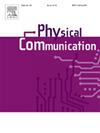Full-duplex (FD) two-way device-to-device (D2D) communications based on dual IRSs
IF 2
4区 计算机科学
Q3 ENGINEERING, ELECTRICAL & ELECTRONIC
引用次数: 0
Abstract
For device-to-device (D2D) communications in the internet of things (IoT), when the direct links between terminals are unavailable owing to obstacles or severe fading, deploying intelligent reflecting surfaces (IRSs) is a promising solution to reconfigure channel environments for enhancing signal coverage and system capacity. In this paper, to improve system spectrum and energy efficiency, a novel full-duplex (FD) D2D communication model with dual IRSs is presented, where two IRSs are deployed closely to two FD transceivers for assisting the exchange of information between them. Given the budget of total transmit power, maximizing the achievable sum-rate of such IRS-assisted FD two-way system is formulated to optimize the precoding at the two transceivers and the phase shifts at the two IRSs. For such a coupled non-convex problem, we decouple it into two subproblems successfully, which can be solved in an alternate manner with low complexity. Simulation results are presented to validate the superior performance of the proposed D2D communication model compared to the existing models and similar optimization schemes.
基于双irs的全双工(FD)双向设备到设备(D2D)通信
对于物联网(IoT)中的设备到设备(D2D)通信,当终端之间的直接链接由于障碍物或严重衰落而不可用时,部署智能反射面(IRSs)是重新配置信道环境以增强信号覆盖和系统容量的有前途的解决方案。为了提高系统的频谱和能量效率,本文提出了一种具有双irs的新型全双工(FD) D2D通信模型,其中两个irs紧密地部署在两个FD收发器上,以协助它们之间的信息交换。在总发射功率预算的情况下,制定最大可实现的irs辅助FD双向系统的和速率,以优化两个收发器的预编码和两个irs的相移。对于这样一个耦合的非凸问题,我们成功地将其解耦为两个子问题,这两个子问题可以用一种低复杂度的替代方法求解。仿真结果验证了所提出的D2D通信模型与现有模型和类似优化方案相比的优越性能。
本文章由计算机程序翻译,如有差异,请以英文原文为准。
求助全文
约1分钟内获得全文
求助全文
来源期刊

Physical Communication
ENGINEERING, ELECTRICAL & ELECTRONICTELECO-TELECOMMUNICATIONS
CiteScore
5.00
自引率
9.10%
发文量
212
审稿时长
55 days
期刊介绍:
PHYCOM: Physical Communication is an international and archival journal providing complete coverage of all topics of interest to those involved in all aspects of physical layer communications. Theoretical research contributions presenting new techniques, concepts or analyses, applied contributions reporting on experiences and experiments, and tutorials are published.
Topics of interest include but are not limited to:
Physical layer issues of Wireless Local Area Networks, WiMAX, Wireless Mesh Networks, Sensor and Ad Hoc Networks, PCS Systems; Radio access protocols and algorithms for the physical layer; Spread Spectrum Communications; Channel Modeling; Detection and Estimation; Modulation and Coding; Multiplexing and Carrier Techniques; Broadband Wireless Communications; Wireless Personal Communications; Multi-user Detection; Signal Separation and Interference rejection: Multimedia Communications over Wireless; DSP Applications to Wireless Systems; Experimental and Prototype Results; Multiple Access Techniques; Space-time Processing; Synchronization Techniques; Error Control Techniques; Cryptography; Software Radios; Tracking; Resource Allocation and Inference Management; Multi-rate and Multi-carrier Communications; Cross layer Design and Optimization; Propagation and Channel Characterization; OFDM Systems; MIMO Systems; Ultra-Wideband Communications; Cognitive Radio System Architectures; Platforms and Hardware Implementations for the Support of Cognitive, Radio Systems; Cognitive Radio Resource Management and Dynamic Spectrum Sharing.
 求助内容:
求助内容: 应助结果提醒方式:
应助结果提醒方式:


